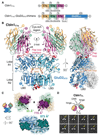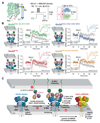Structural basis for integration of GluD receptors within synaptic organizer complexes
- PMID: 27418511
- PMCID: PMC5291321
- DOI: 10.1126/science.aae0104
Structural basis for integration of GluD receptors within synaptic organizer complexes
Abstract
Ionotropic glutamate receptor (iGluR) family members are integrated into supramolecular complexes that modulate their location and function at excitatory synapses. However, a lack of structural information beyond isolated receptors or fragments thereof currently limits the mechanistic understanding of physiological iGluR signaling. Here, we report structural and functional analyses of the prototypical molecular bridge linking postsynaptic iGluR δ2 (GluD2) and presynaptic β-neurexin 1 (β-NRX1) via Cbln1, a C1q-like synaptic organizer. We show how Cbln1 hexamers "anchor" GluD2 amino-terminal domain dimers to monomeric β-NRX1. This arrangement promotes synaptogenesis and is essential for D: -serine-dependent GluD2 signaling in vivo, which underlies long-term depression of cerebellar parallel fiber-Purkinje cell (PF-PC) synapses and motor coordination in developing mice. These results lead to a model where protein and small-molecule ligands synergistically control synaptic iGluR function.
Copyright © 2016, American Association for the Advancement of Science.
Figures




References
Publication types
MeSH terms
Substances
Grants and funding
- R01HD061543/HD/NICHD NIH HHS/United States
- MR/L009609/1/MRC_/Medical Research Council/United Kingdom
- R01 HD061543/HD/NICHD NIH HHS/United States
- L009609/MRC_/Medical Research Council/United Kingdom
- 14414/CRUK_/Cancer Research UK/United Kingdom
- C20724/A14414/CRUK_/Cancer Research UK/United Kingdom
- MC_U105174197/MRC_/Medical Research Council/United Kingdom
- 090532/Z/09/Z/WT_/Wellcome Trust/United Kingdom
- WT_/Wellcome Trust/United Kingdom
- MR/L017776/1/MRC_/Medical Research Council/United Kingdom
- G0700232/MRC_/Medical Research Council/United Kingdom
LinkOut - more resources
Full Text Sources
Other Literature Sources
Molecular Biology Databases
Miscellaneous

